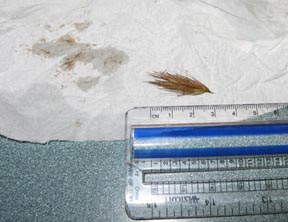foxtail large Colin Chaves

Photo courtesy of Dr. Colin Chaves. This incredibly large foxtail (dubbed "King Foxtail") was brought into the clinic in a lab's ear. Dr. Chaves says the pain goes away quickly once the foxtail is removed. Usually there is no treatment after removal from an ear or nose, but antibiotics are prescribed if there is an abscess in the foot, and if it was in the eye and caused a corneal ulcer, topic antibiotics are used.
Folks who live in the strange lands where rain falls year round may not have met this diabolical tool of evil, but for those of us living in the lands of gold(en brown), foxtails are a summertime menace.
This harmless appearing plant awn looks like the lovechild of a Victorian fan and a Robin Hood arrow. However, its aerodynamic design and delicate barbs are a front for its true nature as an instrument of irritation, infection, and death.
Since humans lack fur, frequently wear shoes, and rarely snuffle face-first through the weeds, foxtails are nothing more than a sock-infesting nuisance for us.
But for non-human animals – well, mammals at least – foxtails act like tissue-destroying missiles, burrowing through skin and trailing bacteria in their wake.
I grew up in foxtail country. Our golden retriever was sent to the veterinarian for more than one excavation of ears, nose, and toes. Still, I never thought of foxtails as particularly serious until I was a veterinary student.
During my senior year, it was a running joke that any patient I was assigned had pus lurking somewhere in its body. Tetris was no exception. A vastly underweight whippet (picture a skeleton with pointy nose and white and fawn fur), Tetris had been rescued from a reportedly disastrous kennel situation – mud, weeds, you name it. He was malnourished and had bed sores, but by the time I rotated onto the clinic, he should have been improving. His bloodwork was horrible and his attitude left a lot to be desired. However, we couldn’t find the source of infection. Several days onto my rotation, Tetris became inflamed along both sides of his spine. The resident and I did an ultrasound on his back, and sure enough, Tetris was developing massive abscesses. A couple of days later, the less than 30-pound dog poured out about a gallon of pus. In the oozy goo? Foxtails. Many of them.
As close as we could guess, the poor guy had been sitting and lying in a literal bed of thorns (well, stickers). Presumably the foxtails had entered his skin where it was compromised by matted feces (sorry folks). They had then gone marching north, all the way to his shoulders, leaving their wake of bacteria. Once we were done with the painful bits of flushing and he got used to me loving on him, his attitude improved. He went from having a bite tag on his cage to barreling across the lobby to see me and leap in my lap when he returned for a recheck.
Because it takes time for the body to summon its defenses and muster up legions of white blood cells, abscesses don’t form immediately. First the area becomes inflamed, and then as the white cells move in and start the war in earnest, the pus forms.
Most animals will show early signs of foxtail incursion: shaking, rubbing, or licking of the affected area; redness of the skin or eye; a wound that won’t heal. If the foxtail isn’t removed, those signs will progress to more obvious signs of infection: discharge and a terrible smell. While it’s rare to have a full-body impact like Tetris had, there are still plenty of instances of dogs developing ascending foxtail infections that penetrate from the toes all the way to the chest wall or nose to lungs.
The arrow shape of a foxtail means that like an arrow, it can only go one direction with ease: further in.
Dogs, probably due to their inability to leave ANYTHING alone, seem to be the worst off. Foxtails are frequent visitors to canine feet, ears, eyes, and noses. Cats can also be impacted but seem to be more resistant, probably due to a lack of compulsory weed-snuffling.
Horses and cattle, while protected by their hooves and wide nostrils, love to collect foxtails under their eyelids, especially tucked in behind the third eyelid. Whenever I saw a horse or cow in the summer with a swollen, oozing, mostly closed eye, I knew there was a good chance that with a little sedation (for the patient) and a steady hand, I was going to get to look like a hero. I think my record was five foxtails from one cow’s eye.
You can take some steps to outfox the foxtail. Mowing, weed-whacking, or sending out the goats before the grasses develop seed heads and dry out is the best start. Keeping known problem children – aka those dogs with vacuums at the ends of their snouts – out of the deep weeds can be a pain, but unless your dog really needs to be one with the wilderness (for instance, a hunting dog), you may want to restrict the summer evening walk to nicely manicured lands. Keeping a dog's feet clipped can help.
A fly mask may help protect equine eyes, but make sure you are removing said mask a couple of times per day to get a good look at your horse’s baby blues or browns. Few things will make you feel worse than taking off a fly mask to find it has been hiding a painful, infected eye.
Whatever you do, remember that the foxtail is a more wily and dangerous opponent than he seems!
3 Comments
Clindamycin farts are foul
June 6, 2023
Colin Chaves, DVM
July 11, 2016
Shanna Compton, DVM
July 11, 2016